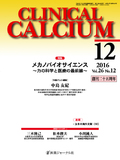Japanese
English
- 有料閲覧
- Abstract 文献概要
- 1ページ目 Look Inside
- 参考文献 Reference
- サイト内被引用 Cited by
長期臥床や微小重力環境による力学的負荷の低減は骨代謝に重大な影響を及ぼす。骨吸収抑制薬は6カ月程度までの検討では骨量減少を防止し尿中カルシウム排泄増加の防止にも有効である。しかし骨形成は力学的負荷に強く依存するため骨形成抑制の長期的影響は不明である。力学的負荷は複数の細胞内シグナル経路を活性化する。このうちずり応力に反応する陽イオンチャンネルを介する細胞内Ca2+濃度の上昇がERK-CREBシグナルを活性化し,AP-1を介するIL-11発現の増加がWnt/β-cateninシグナルを活性化する。Wnt/βcateninシグナルの活性化は力学的負荷への反応性をも高めることから,微小重力環境での運動処方の効果を増強し体軸骨の長期的な骨量・骨強度維持にも貢献できる可能性がある。
Mechanical unloading due to long-term bedrest or microgravity during spaceflight causes a devastating influence on bone. Although bisphosphonates can prevent bone loss and hypercalciuria by mechanical unloading for up to 6 months, the influence of unloading for longer period of time is unknown. This is because mechanical loading is one of the most important stimuli for bone formation. Mechanical stress activates several intracellular signaling pathways. Among them, activation of stress-activated cation channel by fluid shear stress stimulates ERK-CREB signaling to enhance the expression of fos family transcription factors, which stimulates IL-11 expression in osteoblastic cells. IL-11 then enhances Wnt/β-catenin signaling, by suppressing the expression of Wnt/β-catenin inhibitors, sclerostin and Dkks. Because Wnt/β-catenin signal enhances responsiveness to mechanical stimuli, stimulation of Wnt/β-catenin signaling may increase the effect of exercise in maintaining axial bone mass.



